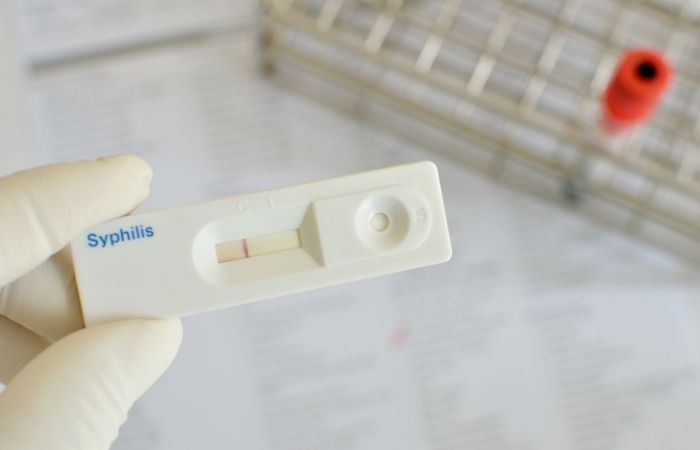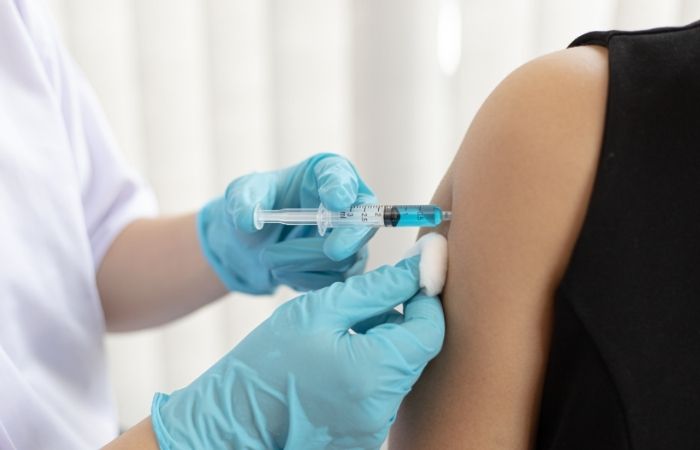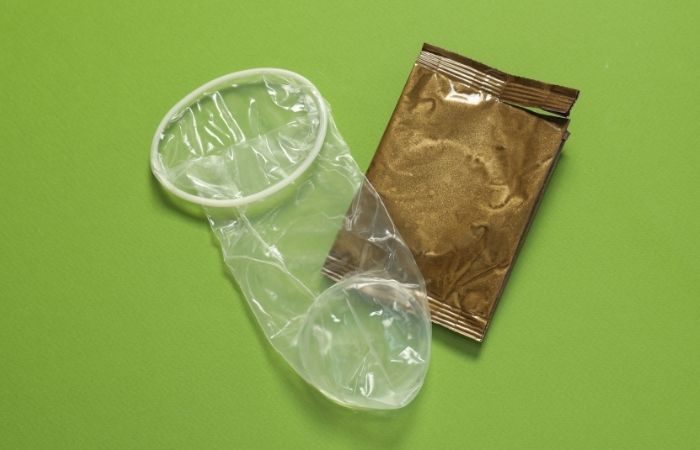The At-Home STD Test That Might Save Your Life
Welcome to campus life. Where STDs are the ultimate uninvited roommate.
More than 1 in 4 college students will get an STD before they graduate. That stat alone should make your skin crawl, but the reality is far worse: most won’t even know they have one. Chlamydia, gonorrhea, and HPV are running laps around university campuses, often undetected until symptoms explode, or worse, until someone else tests positive.
This article isn’t here to shame you. It’s here to spill the tea on what’s really happening in dorm rooms across the country, and what you can do to avoid becoming the next name on the clinic clipboard.
We’ll walk you through the ugly truths, the science behind the risk, real-life horror stories from students, and the hope that comes with smart choices and easy testing. If you’ve ever wondered whether that late-night hookup was worth it, or what’s festering on your roommate’s loofah, you’re in the right place. Let’s talk about the epidemic you didn’t study for: STDs in college.

College STD Statistics Are Terrifying, Here’s Why
STDs aren’t just a “them” problem, they’re a you, your ex, your roommate, and everyone who’s ever borrowed a vape at a frat party problem.
The Centers for Disease Control and Prevention (CDC) reports that people aged 15–24 account for nearly half of the 26 million new sexually transmitted infections each year in the United States. College campuses are ground zero. Why? Think endless casual sex, low condom use, high alcohol consumption, and an overwhelming sense of "It won't happen to me."
Let’s look at the cold, hard facts:
- Chlamydia is the most reported STD among college students, with rates often doubling the national average on some campuses.
- HPV (Human Papillomavirus)? Most college-aged women contract it within their first few years of sexual activity.
- Gonorrhea and syphilis cases are skyrocketing, especially in LGBTQ+ student populations and communities of color.
- And let’s not forget herpes, which spreads like wildfire even without visible symptoms.
What makes this so dangerous is that most of these infections are silent. You won’t know you have chlamydia until it scars your reproductive system. Gonorrhea may only show up in a throat swab, if you even get tested. HPV might be quietly altering your cervical cells until it’s borderline cancer.
The worst part? Campus clinics are often under-resourced, stigmatized, or avoided entirely. Students fear judgment, cost, or even just awkward eye contact with the RA.
STDs don’t just sneak through one-night stands. They slip past good intentions, into long-term relationships, through oral sex, and onto your bedsheets, quietly building into outbreaks. But knowledge is power. And what you’re about to read might just save your sex life.
Check Your STD Status in Minutes
Test at Home with Remedium7-in-1 STD Test Kit

 For Men & Women
For Men & Women Results in Minutes
Results in Minutes No Lab Needed
No Lab Needed Private & Discreet
Private & DiscreetOrder Now $129.00 $343.00
For all 7 tests
The Benefits of Facing the Truth
Let’s get one thing straight: Getting tested doesn’t make you dirty. It makes you powerful. Here’s what happens when students stop pretending STDs only happen to “other people”:
You catch infections early, before they wreck your body.
Chlamydia can cause pelvic inflammatory disease, infertility, and chronic pain if left untreated. Gonorrhea can infect your joints, throat, and even your eyes. Herpes doesn’t go away, but knowing your status helps you manage it and protect others.
You protect your partners, casual or committed.
There’s no bigger buzzkill than giving someone you love (or barely know) a surprise trip to the clinic. Knowing your STD status is the ultimate act of respect.
You get peace of mind.
Ever sat through class wondering if that weird bump is “just a razor burn”? Testing turns anxiety into action. Imagine being able to swipe through Hinge without the constant hum of fear.
You normalize smart sex.
When you talk openly about testing, you change the culture. You give your friends permission to get checked. You make condom talk sexy. You raise the bar.
You save money, time, and heartbreak.
Treating an STD early is cheap. Treating it late can mean surgery, infertility treatment, or permanent damage. Early detection is not just about health, it’s economic survival for broke college kids.
And the best part? You don’t even have to leave your dorm. Withat-home STD test kits, you can test yourself at home, in private, with results in minutes. No judgmental nurses. No awkward urine cups. Just the truth, right when you need it.
It’s not just about sex, it’s about respecting yourself enough to know what’s in your body. Next up? The horror stories and risks no one tells you during campus orientation.

The Ugly Side of Dorm Room Hookups
“I didn’t even know you could get it in your throat…”
That’s what Jake, a 20-year-old junior at a mid-sized university in the Midwest, said after being diagnosed with gonorrhea of the throat, a.k.a. “oral gonorrhea.” His story isn’t unique. Jake didn’t think twice about giving head at a party, especially not to someone he knew “from Econ.” A week later, his sore throat turned into a full-blown infection, and a very awkward conversation with his three other recent hookups.
That’s the thing about college: everyone’s experimenting, exploring, and often doing it under the influence. Combine that with a near-total myth that STDs only show up down there, and you’ve got a petri dish of risk.
Let’s break down some of the most shocking, under-reported campus STD risks:
Oral Sex Isn’t “Safe Sex”
Most students assume oral doesn’t count. But STDs like chlamydia, gonorrhea, herpes, and syphilis can be transmitted just as easily via mouth. The scary part? These infections often show no symptoms when they hit your throat. You could be kissing, sharing drinks, or going down on someone, and spreading an infection you don’t even know you have.
Condoms Are Rarely Used
According to the American College Health Association, only about 54% of sexually active college students used condoms the last time they had vaginal sex. That number drops even lower for oral and anal sex. Condoms still protect best against many STDs, especially HIV, gonorrhea, and chlamydia. But let’s face it, most students ditch them when the mood is right and the drinks are flowing.
Hookup Culture Isn’t Always Honest
Apps like Tinder, Bumble, and Grindr have revolutionized college sex, but they’ve also made it easier than ever to lie, ghost, or “forget” your status. Many students are too embarrassed to disclose an STD, or don’t know they have one in the first place.
Testing Isn’t Routine
You’d think college health centers would be overflowing with resources, but many still only offer limited testing, often only for symptomatic students. And here’s the kicker: most STDs don’t cause symptoms right away, or ever. By the time you feel something’s wrong, you may have already infected someone else.
Let’s not forget the emotional toll either. Imagine finding out you have an STD from your ex’s new partner, because they had symptoms you didn’t. Now you’re stuck in a blame triangle, watching your love life implode over something preventable.
This isn’t about shame, it’s about accountability. Dorms aren’t just breeding grounds for drama. They’re literal breeding grounds for infections when silence and stigma do the talking.
Ready for some hope? Because next, we’re diving into how to actually protect yourself without giving up your sex life.
Order Now $129.00 $343.00 Check Your STD Status in Minutes
Test at Home with Remedium
7-in-1 STD Test Kit




For all 7 tests
Protection Without Paranoia, Yes, It’s Possible
Let’s get real, abstinence-only vibes don’t cut it in 2025. College students are having sex, and honestly? They should be able to enjoy it safely without living in fear. So how do you protect yourself without killing the vibe?
Make Testing Part of Your Routine
If you’re sexually active, especially with multiple partners, aim to get tested every 3 to 6 months. More frequently if you’re having unprotected sex or hooking up with new people often.
Most campus clinics offer free or low-cost testing, but if you’re nervous, busy, or just don’t want to run into your TA in the waiting room, try STD Rapid Test Kits. These kits are discreet, fast, and surprisingly affordable. You can test for chlamydia, gonorrhea, HIV, syphilis, and more, without ever leaving your dorm.
Condoms and Dental Dams Are Sexy
Make protection part of the foreplay. Get creative. Keep a jar of condoms by your bed like it’s a damn candy dish. Don’t let anyone convince you “it feels better without”, what really kills the mood is a burning urethra.
Talk About It
If you can’t talk to someone about STDs, you probably shouldn’t be sleeping with them. Normalize the “When were you last tested?” convo. It’s way less awkward than the “I think I gave you something” text.
Know the Symptoms, And the Lack of Them
Burning pee, discharge, pain during sex, sores, itching? Sure, those are classic signs. But remember, most STDs show no symptoms at all. That’s why testing is non-negotiable.
Bottom line? Safe sex is hot. It’s also powerful, freeing, and damn grown-up.
Get Vaccinated
The HPV vaccine isn’t just for girls, and it’s not too late to start. It protects against the strains most likely to cause cervical cancer, genital warts, and throat cancer. Hepatitis B is another STD-preventable by vaccine, make sure your records are up to date.

Cold, Hard Campus STD Data You Can’t Ignore
You might’ve heard some scary anecdotes, but let’s talk numbers. The kind that shut down denial and make you want to grab a test kit faster than you can say “dorm sex.”
According to the American Sexual Health Association, over 50% of sexually active people will contract an STD by age 25. That covers the vast majority of college students.
A 2023 study published in The Journal of Adolescent Health found that:
- Nearly 1 in 4 college students has had a confirmed STD.
- Only 37% of college students reported consistent condom use.
- A shocking 63% had never been tested for an STD.
- LGBTQ+ students reported higher rates of both exposure and stigma, often avoiding clinics out of fear of judgment or lack of inclusive care.
More data from the CDC shows that:
- Chlamydia is most common among women aged 20–24, with rates hitting over 3,500 per 100,000.
- Gonorrhea rates among 15–24 year olds have nearly doubled in the last decade.
- Syphilis, once thought to be a disease of the past, is rising fast, especially in male-male sexual contact scenarios.
And the wildest part? The vast majority of these infections are completely curable, if caught early. Yet thousands of college students walk around every year with infections that could’ve been prevented or treated, had they just gotten tested.
What Campus Experts and Real Students Say
To get the raw truth, we spoke with health professionals and students across the U.S. Here's what they had to say:
Campus Nurse, Midwest University:
"The biggest issue is shame. Students would rather ignore a weird discharge than walk into the clinic and face someone they know. I’ve treated dozens of students who waited so long that a simple infection turned into a pelvic abscess."
Amber, 21, Junior, Liberal Arts College:
"I had no symptoms. Literally none. My boyfriend tested positive for chlamydia, and I just sat there like, what? Turns out, I had it for months. It damaged my fallopian tubes. I’m 21 and I might never be able to have kids."
Dr. Miguel Estrada, Public Health Specialist:
"STDs are exploding on college campuses because testing isn’t normalized. You wouldn’t ignore a broken leg, but somehow, burning pee is a punchline."
Theo, 19, Freshman, Big Ten School:
"I used to think asking about STDs made me look paranoid. Now I think it makes me look smart. I carry at-home STD tests in my dorm. I’ve used them more than once, and thank god I did."
Students often talk about heartbreak, betrayal, and embarrassment around STDs. But there’s another side too, confidence, clarity, and courage when they take control of their sexual health.
Take Jasmine, a 22-year-old senior who started a campus initiative called “Tested and Proud.” She hands out condoms with stickers that say, “Ask me when I last tested.”
"I wanted to take the fear out of it," Jasmine said. "Because the truth is, if someone won’t talk about testing? I probably shouldn’t be naked with them."
These stories make it clear: there’s no shame in getting tested. There’s only shame in pretending it doesn’t matter.
Check Your STD Status in Minutes
Test at Home with Remedium7-in-1 STD Test Kit

 For Men & Women
For Men & Women Results in Minutes
Results in Minutes No Lab Needed
No Lab Needed Private & Discreet
Private & DiscreetOrder Now $129.00 $343.00
For all 7 tests
Real-Life Ways to Stay Safe Without Killing the Vibe
No, you don’t have to become celibate or delete Tinder to protect yourself. But you do need a game plan.
Here’s how real students are keeping things hot, fun, and infection-free:
The “Third Date Rule”...for Testing
Some students are now making STD testing a norm before becoming sexually active with someone new. One popular approach? "Before we get naked, we both show test results." It’s intimate, it’s respectful, and it’s way more attractive than “Oops, I think I burned when I peed this morning.”
At-Home Kits as a Dorm Staple
Students are stocking their rooms with condoms, Plan B, and now STD Rapid Test Kits. One RA we interviewed said, “If you’re old enough to have sex, you’re old enough to swab yourself.” Preach.
Partner-Up Protection
Couples are making testing a mutual ritual. “We test together every semester,” said one student couple. “It’s part of our routine, like getting flu shots or class registration.”
Normalize the Conversation
It starts in your friend group. If your crew can talk about embarrassing hookup stories, you can talk about getting tested. Once that stigma dies, STD rates will follow.
Turn Condoms into Confidence
Sexy doesn’t stop at consent, it includes protection. Keep condoms where they’re easy to grab (nightstands, wallets, purses), and make it part of the flirtation, not a clunky intermission. When you treat STD protection like self-respect instead of punishment, everything changes. You take back control. You feel more confident. You own your sex life.

STD Myths That Are Wrecking College Campuses
If STD misinformation were an elective, half the campus would be on the Dean’s List. So let’s clean house on the lies that are keeping infections alive and students in the dark.
“I’d Know If I Had One.”
Wrong. Most STDs, like chlamydia, gonorrhea, HPV, and even HIV, can be totally symptomless for weeks, months, even years. By the time symptoms show, damage might already be done. The only way to know? Testing.
“Only People Who Sleep Around Get STDs.”
Not even close. All it takes is one encounter. You could be someone’s first, and still end up with an infection they didn’t know they were carrying. STDs don’t discriminate based on your body count.
“We Only Did Oral, That Doesn’t Count.”
It counts. Oh, it definitely counts. You can get herpes, gonorrhea, syphilis, HPV, and more through oral sex. That’s how throat gonorrhea and “silent herpes” thrive on campus.
“I’m in a Relationship, We’re Safe.”
Monogamy doesn’t protect you from what your partner doesn’t know they have. STDs can be dormant, and past partners’ histories matter. Couples should test together, especially before ditching condoms.
“Only Gay People Get HIV.”
This is not 1985. HIV can affect anyone. Yes, some communities face higher risk due to social and healthcare factors, but anyone can get it, and everyone should be tested.
These myths survive because people are scared. But fear doesn’t protect you, facts do. Kill the rumor mill, share the science, and keep your body (and your friends) safe.
FAQs
1. Can I get an STD from oral sex only?
Yes. Oral sex can transmit herpes, gonorrhea, chlamydia, HPV, and more. You don’t need to go all the way to catch something.
2. How soon after sex should I get tested?
It depends on the infection. For chlamydia and gonorrhea, 1-5 days is usually enough. For HIV, it can take 2-6 weeks to show up. Best bet? Test two weeks after exposure, then again later if you’re worried.
3. What if my partner says they’re “clean”?
That’s not proof. “Clean” is a vague term and doesn’t mean they’ve been tested recently, or for everything. Ask for specific test dates and results.
4. Is discharge normal?
Not usually. Discharge with odor, color, or itchiness often signals infection. Don’t wait, test now.
5. How much does it cost to get tested?
Campus clinics may be free, but if you’re nervous, STD Rapid Test Kits offer affordable, fast at-home tests starting around $30–$50.
6. Will my parents find out if I get tested?
Not if you go off-campus or use an at-home kit. Most colleges protect student confidentiality, but if you're under their insurance, a mailed bill could reveal it.
7. Can I get an STD from a toilet seat?
Nope. That’s an old myth. STDs need skin-to-skin or fluid contact to spread. Toilet seats? Not happening.
8. Do condoms stop all STDs?
They help a lot, especially with fluids-based STDs like gonorrhea and HIV. But herpes and HPV can still transmit via skin contact, so testing still matters.
9. I tested negative. Can I stop worrying?
If it’s been more than 14 days since your last exposure, and you tested for a full panel? You’re probably in the clear. But regular testing is key if you're sexually active.
10. I’m scared to get tested. What if it’s positive?
It’s scarier not to know. Almost all STDs are treatable or manageable. Catching it early is everything. You deserve to know.
The Final Word , Don’t Let Silence Be Your STD
Here’s the thing about college: you’re supposed to mess up. You’re supposed to explore, experiment, and learn who you are. But no one talks enough about the very real risks that come with it, until you’re crying in a clinic waiting room, waiting for answers you weren’t prepared for.
This isn’t about shame. It’s about survival. It’s about respect. It’s about freedom.
Freedom to sleep with who you want. Freedom to protect your health without judgment. Freedom to demand answers and expect honesty from every partner you share your body with.
STDs are not punishments. They’re not a reflection of who you are or how many people you’ve slept with. They’re just infections, and with the right tools, they can be prevented, treated, or managed.
So take a breath. Get curious. Ask your friends when they last tested. Get yourself an at-home STD test and make it a habit. Make protection sexy. Make testing part of the routine, like brushing your teeth or texting your ex at 2am.
Sources
1. CDC - National Overview of STIs in 2023
2. Yale New Haven Health - 3 Most Common STDs Among College Students
3. Sesame Care - The Dirty Secret of STDs on College Campuses










